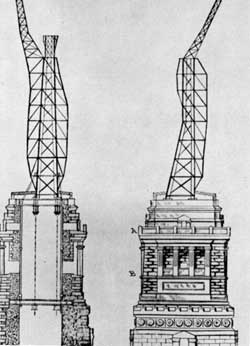“Keep, ancient lands, your storied pomp!” cries she
With silent lips. “Give me your tired, your poor,
Your huddled masses yearning to breathe free,
The wretched refuse of your teeming shore.
Send these, the homeless, tempest-tost to me,
I lift my lamp beside the golden door!”
The immortal words above of Emma Lazarus’s famous 1883 “The New Colossus” are the last 6 lines of the 14 line sonnet cast in bronze at the base of the Statue of Liberty, a colossal neoclassical sculpture located on Liberty Island in New York Harbor. To Americans, she represents the ideals of liberty, freedom, and democracy.
Designed by French sculptor Frédéric Auguste Bartholdi and assembled by Gustave Eiffel (pre Eiffel tower fame), the Statue of Liberty was no ordinary construction project. Standing at an impressive height of 305 feet, the statue’s copper exterior was painstakingly shaped and hammered into place. The interior consists of a framework of iron pylon and steel armature, which enables it to withstand environmental stresses effectively. The statue’s construction took several years, and finally, it was gifted by France to the United States as a sign of friendship on October 28, 1886.
To understand the significance of the Statue of Liberty, it is crucial to examine the geopolitical climate during its construction. In the late 19th century, Europe faced political unrest, authoritarian regimes, and widespread discrimination. France, a cradle of liberty, democracy, and human rights, recognized the importance of displaying these values to the world.
Simultaneously, the United States was witnessing a surge in immigration due to the promise of religious freedom, economic opportunities, and the dream of a better life. The statue welcomed millions of immigrants as they arrived at Ellis Island, marking their entry into the land of opportunity and freedom. To them, Lady Liberty symbolized hope. Hope for a better life. Hope for place to call home.
While the circumstances and motivations may differ, today’s truck drivers are a lot like early immigrants to the US. Many feel undervalued or lost, searching for a sense of belonging.
Undervaluation within the trucking industry can manifest in various ways. Some truck drivers may face long working hours, inadequate pay, and limited access to benefits, leading to feelings of being unappreciated and exploited. This resonates with the struggles faced by immigrants when they first arrived in the United States, where they often encountered challenging working conditions and social exclusion.
Owing to the nature of their work, drivers spend extended periods away from their families and may experience a sense of rootlessness and detachment. This feeling of displacement can resonate with immigrants who have left their home countries and seek stability and a sense of belonging in their new surroundings. Additionally, like early immigrants, many drivers are simply searching for a place to call home.
“Give me your tired, your poor,
Your huddled masses yearning to breathe free”
At SlipSeat, we understand the dynamics that have left drivers feeling undervalued and systematically abused. We are determined to fix this and the other problems that have plagued drivers for decades. We simply want you to know that we are on your side.
Our mission is to solve the driver shortage. The shortage is a result of a broken “system” that allows macroeconomically corrupt driver/carrier transactions to occur. Our strategy is to solve the shortage by fixing the broken system, which will also transform the way truck drivers are treated within the industry.
It became this way because being a motor carrier is much harder than it looks. There are many variables. Keeping track of them hasn’t always been possible, but with today’s technologies, all carriers have the ability to become at least partially informed. Most choose a different path.
Becoming informed requires systems and people, both of which cost time and money. Most trucking companies are small, run by a handful of overworked individuals. They don’t have systems, people, money, or time. Instead, they use pay models to transfer the risk of being uninformed to someone else – in this case, truck drivers.
Traditional Interstate pay models, such as pay-per-mile, percentage pay, and pay-per-load, transfer business risk of the variables to the driver – for example, the risk of traffic, weather, and inefficient dock operations.
These models can compensate for the increased risk, but since drivers don’t maintain the systems and people necessary to track the variables, the drivers are inherently uninformed and therefore do not know how much they should negotiate.
This is further complicated by carriers, who, in a desire to stand out, create proprietary multi-faceted pay models consisting of mileage pay, stop pay, safety bonus, fuel bonus, on-time bonus, etc. When it requires a scientific calculator to compare jobs, it creates confusion.
Everything together creates ambiguity for drivers. Should drivers stay where they are? Should they find a new job? Should they leave the industry? Drivers don’t know. Since this affects nearly every Interstate driver, the collective ambiguity weakens market forces.
Since it is cheaper for carriers to transfer the burden of being uninformed than it is for them to invest in becoming informed, this practice has persisted for decades. After such a long period of time with weakened market forces, sellers (drivers) have no idea what the true value of their service is. This has thrown the truck driver labor market out of balance. It has instituted a shortage in an attempt to restore balance.
The solution lies in restoring balance to the labor market and empowering drivers to make informed decisions about their employment. At SlipSeat, we have developed a cutting-edge tech platform that serves as a billing and payment system but it is specifically designed to level the playing field. It provides drivers with the necessary information and tools to make empowered, informed decisions and ensures fair transactions with carriers.
By embracing this platform, drivers can help us rectify the root cause of the shortage and transform the entire trucking industry. We are not just another company claiming to solve problems. We understand the complexities and intricacies of trucking. And we have your back. We aim to dismantle the existing power imbalances, bring transparency to the labor market, and champion the rights and fair treatment of truck drivers.
Join us in this revolution and help us put the labor market back in balance. Together, we can fix not just the shortage, but also the core issues that have plagued truck drivers for far too long. Together, we can reshape the future of trucking.


